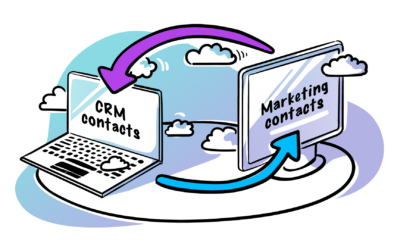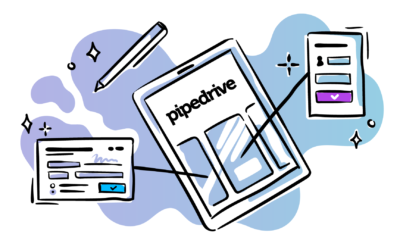Last updated: April 22, 2021
In the Revenue Marketing Clinic series we take a look at the marketing strategies of B2B companies. We take the role of a doctor, analyzing their complaints and concerns, reviewing their symptoms, and offering remedies.
Our first patient Fractory offers sheet metal fabrication services online with instant pricing. It’s a brilliant idea, really—they’ve taken a slow offline procurement process and taken it online.
Anyone who needs sheet metal fabrication can sign up for free, get instant quotes for their designs and order their fabrications then and there (or whenever they’re ready). Fractory is the mediator, giving these orders to their trusted partners for fulfilment.
So, why did they come to us?
Getting an appointment with the doctor
One sunny September day, we received an email from our friend Andreas, who works as a marketing manager at Fractory.
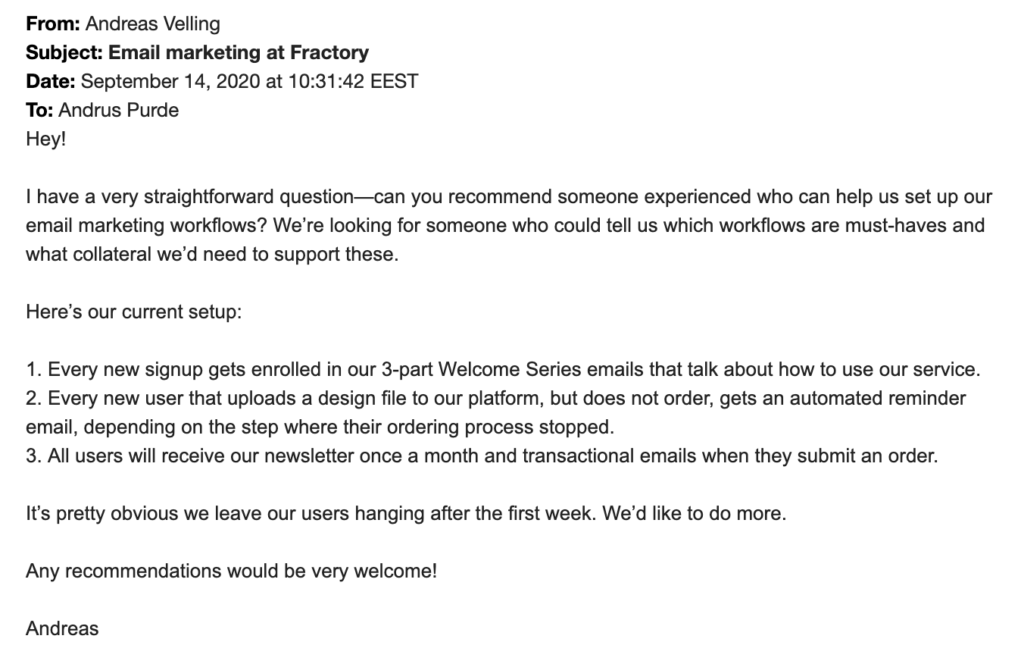
Sounds fair enough, right? They knew they could be doing more to support their signups in the onboarding process. They knew there’s a lot of different automated lead generation, lead nurturing tactics and strategies as well as ways to prevent them from churning in the future.
Surely there’s someone out there who can tell them what works, and help them set it up?
We offered our help in the role of consultants doctors, as we were just getting ready to kickstart our Revenue Marketing Clinic.
Little did they know, we weren’t going to give them a quick fix or a full-blown automated email marketing plan. But we did offer a full checkup, 3 diagnoses and recommended some further analyses bloodwork as well as some handy remedies.
What we found during the checkup
Here’s the thing. We love B2B companies that want to do more automated email marketing, and do it well. But sometimes, wanting to do more of something is not a good enough reason to invest your resources.
To extend the medical analogy: it’s as if Fractory was a young man with some signs of unhealthy habits, who came to the doctor to ask for advice.
“I know I can be doing better. I haven’t had the resources to invest in my health before, but now I do. I just don’t know where to start. Can you recommend someone with experience to tell me what to do—which supplements to take, which exercises to include in my routine, how often and I’ll be on my way.”
Jumping into solutions without a thorough checkup would be bad practice. So we took a few steps back and looked at the bigger picture.
Here’s what we found.
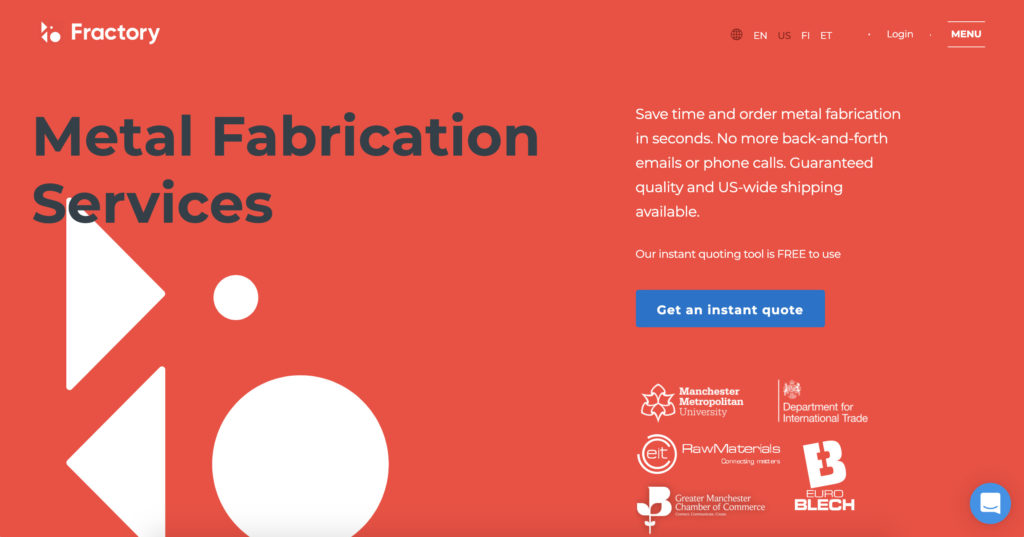
Fractory has done a good job with their content marketing, SEO and some paid ads. They’ve grown their traffic to 100k+ hits per month. Organic traffic makes up the majority of it, all built up around keywords that have to do with their field. From top of the funnel keywords like types of metal, how to process them, to bottom of the funnel—”laser cutting service”, “custom metal fabrication” and so on.
Now, what about the conversions? They get a decent amount of signups* from the qualified traffic, but do not capture leads in any other way. Nearly all signups come from the bottom of the funnel content, i.e. service pages such as the laser cutting service landing page.
*Understandably, we can’t reveal their conversion numbers publicly, so you’ll have to take our word on this.
And the conversion to paying customers? That’s classified information as well, but we can say that the percentage of signups that do make an order is in a healthy range, comparable to any free-to-sign-up platform that has found product-market fit.
Beyond these basic symptoms, we saw some worrying signs. They do not know why the rest of the signups don’t end up making an order.
“Sales probably has some insights into this, but we don’t have any systematic data”.
Furthermore, they don’t have any measures in place to measure the impact of marketing on deals created or revenue generated. While they track the key conversion metrics, whenever sales take over a customer journey, the marketing team loses track of the impact of their work.
Last, but definitely not least, the team at Fractory does not know where they’re missing out on most revenue. More about this in the next section.
The diagnosis and what the doctor ordered
Before giving Fractory any specific guidance, I convened with my the top-notch B2B sales and marketing experts I happen to share an office with (ex-head of marketing of Pipedrive included, no big deal). We held a meeting to discuss the patient’s health extensively.
The result? We came up with 3 key diagnoses and suggested the following action-items.
Diagnosis 1: Revenue FOMO
Key action-item: further analyses to decide where to focus
Fractory came to us with the intention to start doing more automated email marketing to support their customers on their journey.
They had the fear they’re missing out on revenue, somewhere in their funnel.
However, there are no guarantees that any drip email campaign or series of cart abandonment emails will improve the conversion rates or lower the churn rates of Fractory (sorry, no shortcuts!).
The first step we recommended to Fractory for getting better? More specialized analyses!
In order to know where to focus your marketing automation resources, first find out where your biggest missed opportunities are.
More specifically, here are a few concrete tests and analyses we recommended to Fractory:
- Onboarding analysis. Find out the reasons why people sign up but don’t end up making their first order. And then rebuild the onboarding process and emails to address the biggest obstacles the users have.
Don’t get us wrong, there’s nothing really amiss with Fractory’s current welcome series emails. For example, here’s the first of the three:
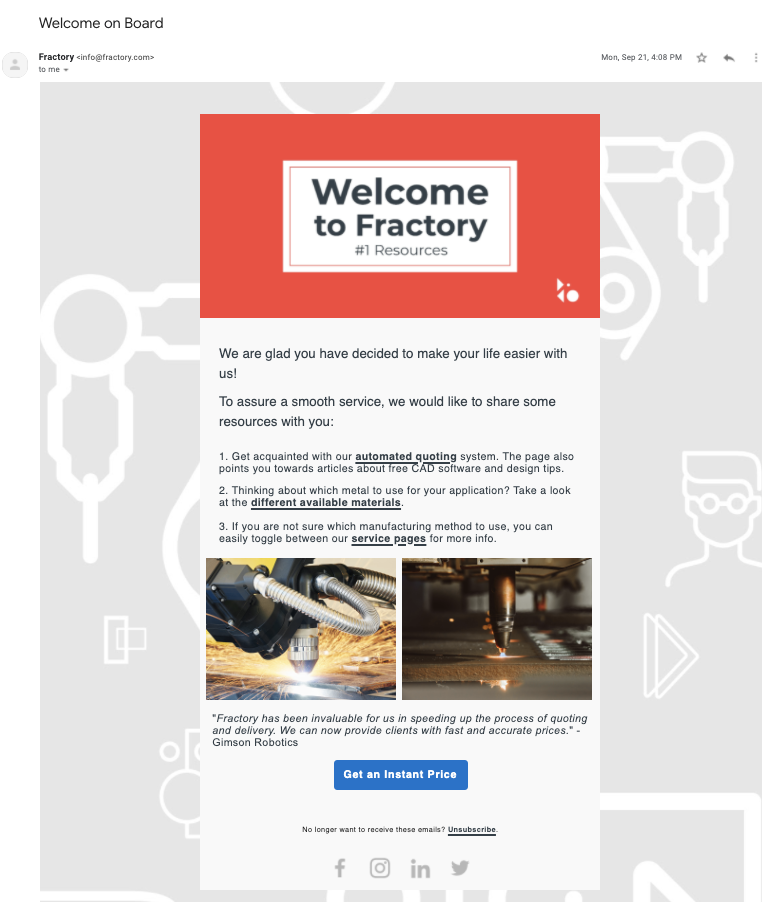
The performance stats? Open rate: 47.4%; Click rate: 9.8%
But do these suggested three resources best address the new user’s questions or hesitations? We’re not convinced.
The click rate is not bad, with about 3.3% of the 9.8% clicking on the CTA at the bottom, and another 3.3% clicking on “different available materials”.
However, given that the 2nd and 3rd email’s open and click rates are way lower (37% and 32%; 2.4% and 1.1% respectively), we’re certain they could be doing better.
Truly, there’s only one way to find out what to address in your onboarding emails. By asking the new users where they get stuck, of course! Read more about how we went through this analysis before automating our onboarding.
One quick tip we did give them for the onboarding emails: the Get an Instant Price button was linking to Fractory’s home page, while the intention was to get them back on the platform. Naturally, we suggested they replace it with a link that takes them in the app instead.
- Churn analysis. Fractory has set up cart abandonment reminder emails with Klaviyo that get sent to everyone who starts their first order but does not complete it.
They’ve seen some success with these, and even A/B tested subject lines. See for yourself, the open and click rates are pretty good:

One quick tip: as you can see, the technical “Fractory quote {{ event.OrderId }}” subject line variation is performing way better than the other one. We suggested they continue with just the better-performing one.
In order to know which workflows to build next, we suggested they analyze their current churn.
How many customers are churning after 2, 3, 4 or 10 orders? What’s the first sign someone is churning? When the customer has gone 2 weeks without an order? 1 month? 2 months? What are the most common reasons for churning?
Yet again, the only way to find out is to do the heavy lifting by analyzing their data and talking to the customers. Fractory has tracking in place for churners, but so far just have anecdotal insights from sales regarding the reasons for churn.
Once the reasons are clear, it’ll be time to test different incentives, content and campaign ideas to improve the biggest dropoff points.
Diagnosis 2: No lead capture
Key action-item: Start building an audience
This diagnosis was a no-brainer. Kind of like how you know you should be eating your greens and getting your 10,000 steps in.
The marketing people at Fractory already knew they needed to have lead capture forms on their website.
Let’s hope the doctor ordering this gave them the final push to put this into practice and start working on lead nurturing. We’ll follow up on this soon enough.
We did go a little further than this captain-obvious advice though, and offered them some specific tips on how to go about building their audience.
First pointer: be intentional about your content. Till date Fractory has been sending ~1 newsletter a month to their entire list of people who sign up for their platform.
Here’s an example:
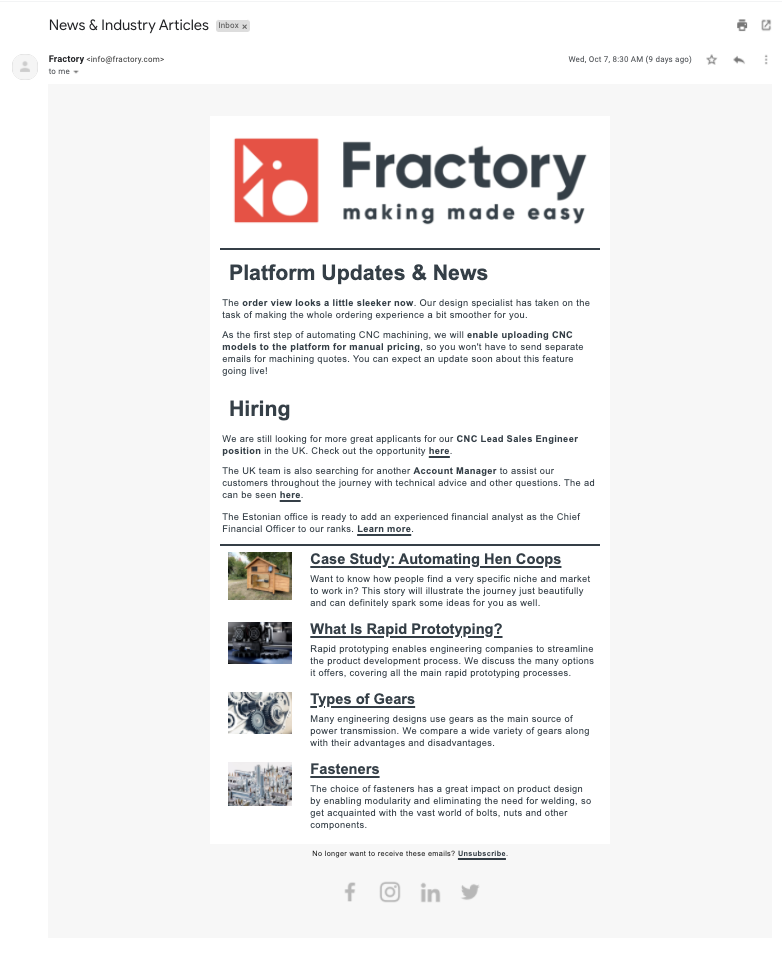
A side-note: they intended to give this newsletter a different subject line, but it didn’t save properly. Surprisingly enough, this bland “News & Industry Articles” ended up having one of their best open rates of all time. Take note and experiment once in a while. 😉
It’s a messy mix of product news, hiring announcements, industry news and educational content. It’s lacking focus.
Best practice would be to separate product news and marketing/educational content (and plug in hiring announcements only in the latter). In this way, subscribers have the power to choose what content is relevant to them, and they have a better experience of being your subscribers. And you get better results.
If you have the capacity, you can segment your content and audiences even further, and give people options as to what kind of content they wish to receive (by topics, format, etc).
Diagnosis 3: Revenue impact of marketing not measured (yet)
Key action-item: Start building insights
If you’ve stumbled across our content before, you’ll know we’re always talking about measuring the revenue impact of your marketing. So, we obviously went on a rant about this when we realized the ROI of Fractory’s marketing was not measured in a straightforward way.
During our discussions, Andreas revealed that finding a reliable and meaningful way to measure the revenue impact of marketing has proven to be a challenge. Here’s what he said:
“Most tools measure revenue impact of campaigns through last non-direct attribution, which is not ideal to say the least. In that model, simply sending emails more frequently will result in more revenue attributed to email marketing—which renders the tracking meaningless.”
Most tools measure revenue impact of campaigns through last non-direct attribution, which is not ideal to say the least. In that model, simply sending emails more frequently will result in more revenue attributed to email marketing—which renders the tracking meaningless.
While we offered Fractory an action-item on this, it turned out they’re working on a solution for this already. One of their team members has spent the last 6+ (!) months building a system that would help them track and analyze marketing analytics.
They’re taking a deep-dive into attribution models and are working hard to implement a custom multi-channel attribution model. The goal is to get meaningful insights of marketing activities and, really, their entire buyer’s journey.
Fractory’s dedication to building this is laudable. We’re looking forward to getting a glimpse of their system, once they forgive us for publicising some of their medical records in this blog post.
Shameless plug: we at Outfunnel believe getting insights into the revenue impact of B2B marketing should be as easy as pie. While we’ll probably never offer revenue intelligence that would be as nuanced as a custom-built attribution model, we do offer some nifty revenue marketing features. Our goal is to give SMBs a high-level overview of how different marketing campaigns and channels perform.
In the end, it’s up to the marketing leader to decide: how much data is sufficient to take revenue responsibility with confidence.
Revenue Marketing Clinic #1 in summary (the TL;DR)
While we had a lot of fun playing a doctor to Fractory’s marketing department, here are our practical takeaways:
- It’s great to have a desire to do more automated email marketing, but it’s a weak starting point for putting together a strategy.
- When you’re ready to deep-dive into marketing automation, first look into why people fall off in each stage of your funnel. And then build the workflows to address these.
- Most likely, you already know where you’re lacking or what you could be doing better—and having someone from outside say “start here!” can be a good kick to get you going.
- Analyzing revenue impact is not a simple or straightforward matter—and often requires a decision of how much data is good enough to make decisions.


